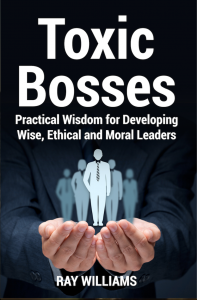By Ray Williams
March 21, 2021

Let me begin by saying that in my 35 years as a leadership trainer and executive coach, I have worked with some of the finest inspirational and productive leaders who exhibit humility, compassion and a dedication to service to others.
Then there are the others. Far too many of them.
Millions of people face abusive supervisors and bullies at work. These employees are targets of ridicule, threats, or demeaning comments by their manager on a daily basis, which results in decreased satisfaction, productivity, and commitment to the job as well as the organization at large.
In a study published in Work Stress, authors Aaron Schat and Michael R. Frone, describe the prevalence of workplace psychological aggression (WPA), which involves behavior that is characterized by a verbal or symbolic act, the typical immediate effect of which is psychological harm (e.g., fear, anxiety). Examples of WPA include being shouted at, insulted, or threatened at work. They report “exposure to WPA is far more common in the workforce than is exposure to workplace physical violence. US data show that 41.4% of American workers reported exposure to workplace psychological aggression during the preceding 12 months.”
Manuela Priesemuth, a management professor at Villanova University, has written an article entitled, “Time’s Up for Toxic Workplaces,” published in the Harvard Business Review. She argues, “While direct interactions with ‘bad bosses’ can be traumatic for employees, the problem often goes further than a single individual. Indeed, some of my own research has shown that abusive behavior, especially when displayed by leaders, can spread throughout the organization, creating entire climates of abuse. Because employees look to and learn from managers, they come to understand that this type of interpersonal mistreatment is acceptable behavior in the company. In essence, employees start to think that ‘this is how it’s done around here,’ and this belief manifests itself in a toxic environment that tolerates abusive acts. More so, studies have even shown that employees who experience abuse from a supervisor are also more inclined to pass on this type of treatment in a ripple effect.”
Priesemuth says toxic workplaces also impair the lives of individuals beyond the work realm. Employees report feeling emotionally drained, experience lower well-being, and even increased conflict at home (i.e., work-family conflict).
In their study, Mary Bardes Mawritz and her colleagues at Drexel University, University of Michigan, and the University of Illinois, published a research paper entitled “A Trickle-Down Model of Abusive Supervision,” in the journal Personnel Psychology.
They concluded “we find that abusive manager behavior is positively related to abusive supervisor behavior, which in turn is positively related to work group interpersonal deviance. In addition, hostile climate moderates the relationship between abusive supervisor behavior and work group interpersonal deviance such that the relationship is stronger when hostile climate is high. The results provide support for our trickle-down model in that abusive manager behavior was not only related to abusive supervisor behavior but was also associated with employees’ behavior 2 hierarchical levels below the manager.”
The researchers argue thetrickle-down theory of aggressionstems from social learning theory and proposes that individuals are likely to model the aggressive behavior of those in positions of higher status, suggesting that aggressive behaviors can trickle-down from one hierarchical organizational level to the next.
Erica Mildner, at the University of British Columbia, in her article in The Conversation, described the problem of toxic workplaces. She reports that n Canada, the emphasis on workers’ right to a safe and healthy workplace in the wake of former governor general Julie Payette’s resignation provides a rare opportunity to expand the definition of workplace harassment and hold toxic bosses to account — just as serial sexual abusers have been outed and held responsible during the #MeToo movement. And New York Gov. Andrew Cuomo has been accused of toxic leadership for years, for example, yet he is only facing public censure and an impeachment investigation following recent sexual harassment allegations. And finally, this summer, a British KPMG executive resigned after he told employees to “stop moaning” about pay cuts, while also labelling the concept of unconscious bias as “crap.”
The notion of a trickle-down effect of behavior is supported by the central tenets of social learning theory. The ideas that individuals are more likely to role model behaviors that attract their attention and are commit- ted to memory imply that subordinates are likely to observe and mimic the behaviors of their immediate supervisors. Supervisors are usually highly visible to those subordinates one hierarchical level below them. In these proximal leadership situations, subordinates are more likely to attend to and have the most contact with their immediate supervisors. Therefore, subordinates have many opportunities to observe their supervisors and gain information about appropriate behaviors from these significant authority figures.
Workers have experienced demeaning comments from a supervisor, verbal aggression, surveillance and sometimes even physical threats or intimidation. But what if these behaviors were treated as seriously as other forms of workplace misconduct?
In my article, “The Rise of Toxic Leaders and Toxic Workplaces,”, I describe in detail the fact that books, articles, seminars and speeches abound espousing the virtues of great leaders, effusive in their description of men and women who are selfless, humble, empathetic, compassionate, emotionally intelligent and altruistic. Hordes of consultants, university professors, researchers and coaches make their living espousing the need for choosing these kinds of leaders. The truth of the matter is that we are hypocrites, and we are witnessing the rise of toxic leaders and workplaces.
We tend to choose or follow a very different kind of leader. We hire and promote the psychopaths, the narcissists, the bullies and the autocrats dedicated to self-interest, and whose long-term impact has and can damage and even destroy organizations (and even countries). In my two decades as an executive coach, I have encountered more of the leaders described in this paragraph than those described in the first paragraph. Many people easily forgive these toxic leaders and the harm they cause because they measure their success solely in financial terms or because they bring charismatic entertainment value to the organization.
In my book, Eye of Storm: How Mindful Leaders Can Transform Chaotic Workplaces, I describe in detail the characteristics of toxic workplaces, and the part that dysfunctional leaders play in creating them. Toxic workplaces can be characterized as follows:
- All sticks and no carrots. Management focuses solely on what employees are doing wrong or correcting problems, and rarely give positive feedback for what is going right. Or mostly carrots for the best performers, sticks for the the rest.
- The creeping bureaucracy. There are too many levels of approval and management to get things done and a singular focus on micromanaging employees.
- The gigantic bottom line. A singular focus on profits, beating the competition and cost cutting without consideration of other bottom lines.
- Bullies rule the roost. Bullying of employees by management, or tolerated by management when it occurs among employees.
- Losing the human touch. People are considered to be objects or expenses rather than assets, and there is little concern for their happiness and/or well-being;
- High levels of stress, turnover, absenteeism and burnout.
- Instituting internal competition among employees enforced by a performance assessment system that focuses on individual performance rather than team performance.
- Little or no concern for work-life balance, where a personal or family life must be sacrificed for the job.
- Overwork or workaholism, commonly evidenced by 50 hr.+ workweeks, little or no vacation time and 24/7 availability for work communication.
- Little evidence of leaders’ compassion and empathy for employees.
- Little or no commitment to making contributions to the community, worthy causes or making the world a better place.
Theo Veldsman of the University of Johannesburg published a study on the growth and impact of toxic leadership on organizations. He contends that “there is a growing incidence of toxic leadership in organizations across the world.” Veldsman says that anecdotal and research evidence shows that one out of every five leaders is toxic, and he argues according to his research, that is closer to three out of every ten leaders. Veldsman describes toxic leadership as “ongoing, deliberate intentional actions by a leader to undermine the sense of dignity, self-worth and efficacy of an individual. This results in exploitative, destructive, devaluing and demeaning work experiences.” He goes on to say that a toxic organization is one that “erodes, disable and destroys the physiological, psychosocial and spiritual well being of the people who work in it in permanent and deliberate way.
INSEAD business school Professors Gianpiero Petriglieri and Jennifer Petriglieri, authors of “Can Business Schools Humanize Leadership?” have coined the term “leadership industrial complex,” which they say promotes a view of leadership that is depersonalized and sanitized: “Over one decade of corporate scandals, financial meltdowns and growing inequality has consolidated a disconnect with business and political leaders, as it is in the protests in the streets and squares around the globe.” Leaders now are no longer seen as being role models or stewards of the common good, but rather as predatory plutocrats who profit disproportionately at the expense of the majority of the population. G. Petriglieri and J. Petriglieri argue that we have experienced a “dehumanization of leadership” in which leadership is reduced from a cultural enterprise to a strict intellectual or commercial one, and in which leadership “distances aspiring leaders from their followers and institutions, resulting in a disconnect their inner and outer worlds.”
In my book, I Know Myself and Neither Do You which focuses on the importance of leader self-awareness, I argue the following.
In two surveys by the Workplace Bullying Institute (WBI) and Zogby International, where bullying was defined as “repeated mistreatment: Sabotage by others that prevented work from getting done, verbal abuse, threatening conduct, intimidation and humiliation.” And 35% of workers experienced bullying first hand, and 62% of the bullies were men. A Harris Interactive poll conducted in 2014 revealed that 34% of women reported being bullied in the workplace. A 2016 U.S. News and World Report poll says that 89% of U.S. workers said incivility is a serious problem and 78% said it is getting worse.

Reports of “toxic workplaces” and “toxic bosses” proliferate news and social media stories, where a significant number of employees want to leave their jobs because of abusive bosses. In The Corporation, the hit 2003 documentary film, businesses are portrayed as psychopaths that can wreak havoc in the communities where they operate, something that is becoming increasingly commonplace.
Relentless demands, extreme pressure and ruthlessness are all trademarks of a toxic company, as is a twisted disconnect between what a firm says it does for employees and what it actually is doing. People are looked at as costs, rather than assets.
All these descriptions of dysfunctional and unhealthy organizations have been contrasted with progressive organizations and their leaders, who understand and value the well-being of employees as central to the long-term success of the organization.
The World Economic Forum’s 2015 Survey on the Global Agenda revealed that 86% of respondents perceive a global crisis in leadership. The survey assessed the general concerns and issues about leadership, not the specific issue of leadership during a crisis. That deficiency is more disconcerting in the face of increasing global social, political and economic complexities and now, pandemics. A study by Deloitte’s Center for the Edge shows that the effectiveness of management in has been steadily falling for the last 50 years.
According to the National Leadership Index report, 75% of organizations reported a deficit of leadership skills. Forty-two per cent of managers rate their own line-manager as ineffective; 70% of Americans still believe they have a crisis of leadership.
A 2016 Gallup poll found that only 18% of managers demonstrate a high level of talent for managing others–meaning a shocking 82% of managers aren’t very good at leading people. Gallup estimated that this lack of leadership capability costs U.S. corporations up to $550 billion annually.
In a 2016 McKinsey & Company study of more than 52,000 managers and employees, leaders rated themselves as better and more engaging than their employees did. This included 86% of leaders who believed they model the improvements they want employees to make, while another 77% of leaders believed they “inspire action.”
A study by the Corporate Leadership Council concluded that the billions upon billions of dollars spent on leadership training have improved productivity by only 2%. It appears that the major reason for the failure has nothing to do with technical competence, or knowledge, or experience, but rather with hubris and ego, most often linked to a lack of emotional intelligence and particularly, self-awareness.
In my new book, Toxic Bosses: Practical Wisdom for Developing Wise, Ethical and Moral Leaders, I exam the prevalence of unethical and amoral leaders and make practical suggestions on what organizations and individuals can do about it. I argue“leaders with low-ethical standards amplify theirsubordinates’ propensities to morally disengage. Forinstance, if one has a leader who definessuccess in terms of results rather than the means throughwhich they are obtained, subordinates could more easilymorally justify short-changing customers in the interest ofprofit (and the greater good of company performance).
Leaders who demand obedience or absolute loyalty from their subordinates facilitate their subordinates’ displacement of responsibility, such that individual employees can shift their moral agency onto their domineering leader. A leader who refers to clients or competition as a resource to be exploited or an enemy to be overcome can support euphemistic labeling of harmful practices or the attribution of blame for mistreatment onto those whom they are harming.
Similarly, a leader’s exclusive focus on profits, emphasizing meeting targets, goals, and operational efficiencies can create a situation in which unethical behavior has no apparent victim.
Leader behaviors that can be considered unethical include falsifying information, provoking distrust among others, blaming followers for their own mistakes, and showing favoritism in exchange for self-serving actions. In distinguishing ethical from unethical charismatic leaders, researchers noted that unethical leaders use power for personal gain; promote their own personal vision; censure opposing views; demand their own decisions be accepted without question; engage in one-way communication; show insensitivity to followers’ needs; and rely on convenient external moral standards to satisfy self-interests.
We are in a leadership crisis when it comes to confidence in our political and business leaders. We say we want empowering, humble, and kind leaders—bolstered by research evidence—but we often choose authoritarian, controlling, narcissistic and toxic leaders. Perhaps it’s time for the general public, recruiters, and leadership development experts to end the contradiction and do what’s best for our organizations and society.
Read my latest book available on Amazon:Toxic Bosses: Practical Wisdom for Developing Wise, Moral and Ethical Leaders,


